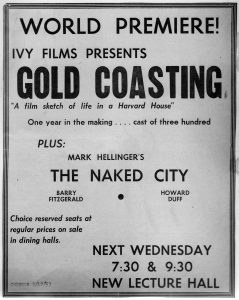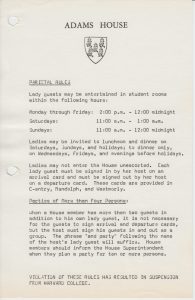“A film sketch of life in a Harvard House”, the 1953 Gold Coasting by Nelson Galassi ’53, was long considered lost to the public, as only a negative without sound was preserved in the Harvard Archives. But thanks to diligent efforts by the Franklin Delano Roosevelt Foundation and the wonderful generosity of Joel Mandelbaum ’53, the composer of the original music score, the film has been restored. Using his original notes and prodigious memory, Dr. Mandelbaum, professor emeritus at Queens College, CUNY, re-scored the film and then organized student musicians and vocalists to re-record the soundtrack. With his marvelous efforts an invaluable piece of Adams House history has been rejuvenated and preserved.
Below is a a conversation I had with Joel Mandelbaum ’53 discussing his soundtrack.
MW: First of all, Joel, I want to thank you for your magnificent dedication in restoring the soundtrack for the film Gold Coasting. Had I known the complexity of what I was asking when we first hatched this idea five years ago, I don’t think I would have had the bravado to have made the request.
JM: Actually, Michael, I was glad to do it. In fact, I didn’t prod you too much to find the original score because I was looking forward to having a go at this.
MW: Really? In all fairness, we DID search high and low for the actual soundtrack before asking you to take this on. Nelson Galassi, the writer and director, didn’t have a copy. Nor did the Harvard Archives; only the silent film. We queried everyone we could find, but to no avail. The music, which you recorded post-production, was officially declared lost.
But we’re ahead of ourselves. Let’s start at the beginning: tell me a bit about how you became involved with writing the music for Gold Coasting.
JM: It was all the creation of Nelson Degassi. He was in the House and the Vice President of Ivy Films…
MW: Ivy Films? Was that some sort of student organization?
JM: Yes, a very active one. They produced quite a number of original films every year, and Nelson Dagassi was very much involved. He had this idea to do a short about Adams House…
MW: So, essentially, he just came to you one day and asked you to write the score?
JM: Pretty much. I was a music concentrator, and had written a cantata about Adams House for the Glee Club in my sophomore year. He knew about that, and asked me if I would be interested in writing for the film. It was a departure from what I was doing — I was in the middle of writing a concerto — but it seemed like a fun project, so I agreed.
MW: Being non-musical myself, I can’t imagine how you would even begin such an undertaking.
JM: Well, as I said, I had written the cantata, which provided the frame and fit nicely into some of the scenes. The fight song, for instance, worked well for the opening and credits, the “good food” song for the dining hall sequence, etc. Then it was just a question of writing the linking passages.
MW: I really think the score is fantastic, Joel: it goes from the lyrical — I’m referring particularly to some of the marvelous solo bassoon parts — to the downright jaunty, à la Gilbert and Sullivan.
JM: (Smiling) I’ve been a Gilbert and Sullivan fan all of my life, so if you hear a resonance of Gilbert and Sullivan there, I’m pleased. The bassoon part you mention was due to the fact that one of my great friends was an incredibly talented bassoonist and I wanted to give the part full range.
MW: And then there is that amusingly honky-tonk music for the formal dance. Do I sense something of a parody there?
JM: (Sounding a bit sheepish) Yes, there’s a story behind that…
MW: Go on….
JM: I had written a little ditty with ribald lyrics as a joke for my friends. They of course recognized the tune when they heard it in the film…
MW: How ribald? This is the early ’50s after all, it can’t be that indecorous. Can we know the lyrics?
JM: (Smiling) Absolutely not, and I want a promise from you not to go digging for them.
MW: (Laughing) So sworn! But I can pretty much guarantee you they are safely lost to posterity.
Music aside for a moment, it’s really remarkable how in watching this now, you get a sense of pent-up sexual angst. It’s almost palpable.
JM: (Simply) Of course.
MW: Of course?
JM: Yes, of course. You know one of the songs from my Adams House Cantata is about why Adams House was so popular then. It had to do with location — and all those doors! It goes:
For the greatest delight,
Just try starting your night at an Adams House dance,
Everything will go right
What a place to entertain your girl!
MW: (Laughing) Indeed! As a classicist, I can assure you that the Romans didn’t call those single narrow entrances to their houses fauces, “jaws,” for nothing! How the residents of Kirkland or Lowell must have envied you! Speaking of that: There is a scene I don’t fully understand. At 11:40 a man in uniform enters a room and hands the occupant a paper. It looks like a citation. A violation of the parietal rules?
JM: That’s what I think it was, too. Though I never saw a uniformed man giving a notices like that, but then again, I never violated those rules.
MW: Seriously? Just between us… Never?
JM: Nope. (Pause, sensing my disappointment)
Sorry! (Laughing)
They were very serious about those rules, and no one I know ever violated them. But then again, there was really no reason to disobey them, because if you were determined, you had plenty of opportunity to get up to “whatever” during official visiting hours, so to speak; there was no reason to risk anything after hours — despite what you see in the film plot.
MW: (Smiling) I see… creative license! Getting back to the music. How long did it take to record the score?
JM: Originally? I really don’t remember. This time, we spent three hours in the studio with our undergraduates [of Queens College] and then a number of hours of post-production. The musicians and vocalists were very talented. The hardest part was getting my arms to last through conducting all those speed-ups and slow-downs. Quite a feat at my age!
MW: How did you even go about restoring the score? Had you kept the music all this time?
JM: No, only my notes.
MW: Saving notes for 60 plus years, that’s amazing!
JM: (Laughing) I’m a pack rat. So, for this go-around, I had a large portion of the original score preserved. The major difference between the original score and the new soundtrack is that the linking passages were originally for solo piano or piano and violin, and now they are scored for orchestra.
MW: Well the result is nothing short of spectacular. It brings a long-lost piece of Adams history back to life. Tell me, Joel, in going back to something you wrote 65 years ago, what were your impressions? After all, you’ve had an immensely successful career composing and teaching music. How do you think your young self measured up?
JM: Reasonably well. That is to say, I didn’t feel the need to alter anything significantly. Of course, there was a touch of careless craft here and there: we did the project fairly casually, never suspecting that we’d be discussing it six decades later.
MW: Yes, 66 years in fact! The black and white images on film are so much of a lost age — completely different in almost every way from the Harvard undergraduate experience of today, and as such, really requiring a bit of imagination to interpret even for someone like me who arrived on the scene just 30 years later, and even more so for our current students 30 years on again. But what struck me is how your music alters those dated images — and how the music, in contrast to the pictures, has not aged. When I first saw this film without sound, it was intriguing, but lifeless. Now, thanks to you, Gold Coasting is alive again.
JM: That’s very kind of you to say that.
MW: On behalf of Adams House and the Franklin Delano Roosevelt Foundation, I can’t thank you enough, Joel.
JM: It was my pleasure, Michael.


